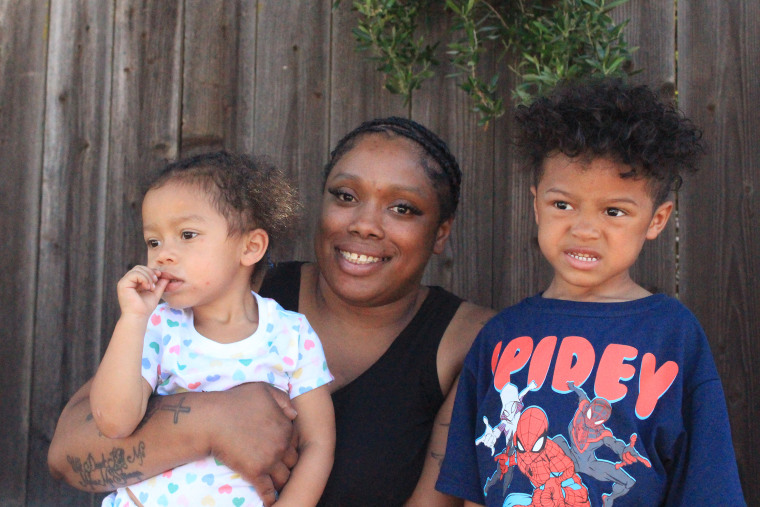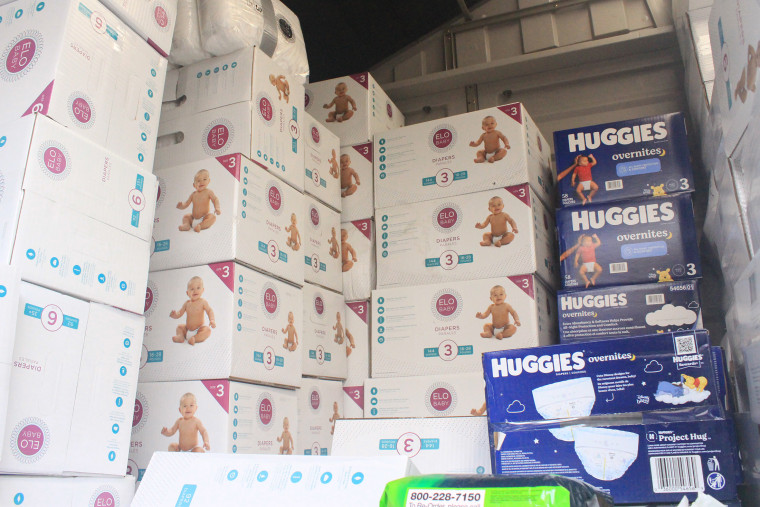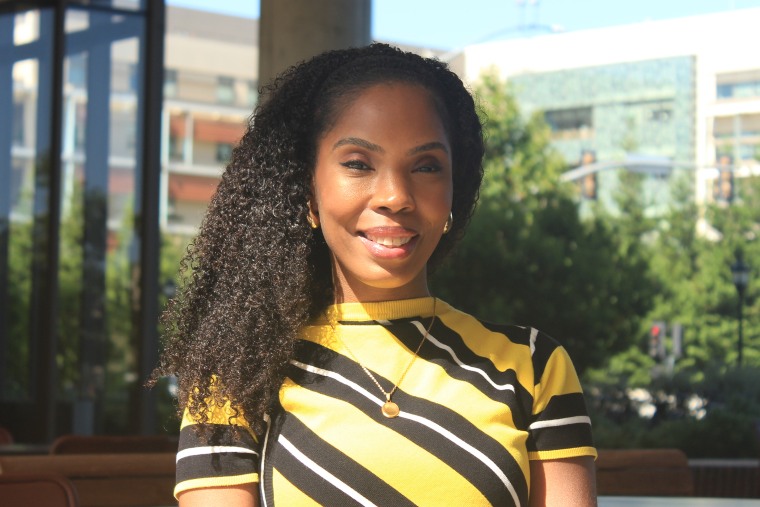On a sweltering afternoon in June, Angelia Victorian waited in the parking lot of a Head Start preschool in Fremont, California, with precious cargo in the trunk of her car — a box of Size 3 diapers.
Victorian, a social worker for the Alameda County Health Department for the last 16 years, was waiting to meet a young mother of two to hand her the diapers and check on the family’s well-being.
“Some families don’t have a home, so we have to meet them wherever they’re at, whether it’s at McDonald’s or Walmart in the parking lot,” said Victorian.
With rising costs, more families in California and across the U.S., especially those with very young children, are struggling to cover day-to-day expenses. Parents that Victorian works with have three major pressures:
“Housing, food and diapers, in that order,” she said.
Moments later, Diola Lucero, 30, a single mom from Newark, California, walked out of the preschool holding her two children. Having previously been homeless for about three years — moving her family from an RV to a car to an emergency shelter, and now living in Section 8 housing — Lucero has sought diapers from a distribution program in the county since her now-4-year-old son was born.
With Lucero’s family living out of state, the county support is her only safety net.

Without enough diapers, she says, she’ll have to push her 2-year-old daughter to potty train because of the high cost.
“To be honest, when I go into the store, I don’t look at the type of diapers that I want. I always go for the cheapest brand,” she said. “Because money is really tight.”
Lucero has to make choices daily between necessities such as food and clothing, and diapers. She has grown accustomed to putting her children’s needs first and her own last.
Choosing between clean diapers and food
Nearly 50% of Americans with young children cannot afford all the diapers their little ones need, according to the National Diaper Bank Network. About 25% of those families reported missing work because they didn’t have enough extra diapers to give to child care facilities. Since the pandemic, the price of diapers has reportedly increased 48%, costing families as much as $1,000 a year per child.
“No family should have to choose between clean and dry diapers for their family or food. No parent should have to stay home from work because they can’t afford the diapers required to take their child to day care,” said Lacey Gero, director of government relations at the National Diaper Bank Network.
Diaper banks have long helped low-income families. In California, for example, a $30 million limited-term state fund that provided free diapers to needy families over a three-year period ended on June 29, although legislators managed to negotiate a $9 million budget for the next two years.
It’s a critical need: In California alone, diaper banks distributed 78 million diapers in 2023, said Assemblymember Liz Ortega, who had been fighting to protect the state diaper fund.

Given the much smaller amount of money set aside for diapers, Ortega has introduced the Medi-Cal diaper bill, AB 2446, legislation that would further expand the definition of “medically necessary” under the state’s Medicaid program so families with children under 5 could get free diapers. California currently covers medically necessary diapers for children over the age of 5. A medical necessity for diapers can include conditions such as recurring urinary tract infections and diaper rash.
If the bill passes later this year, California would become the latest state to add diapers to Medicaid.
Last year, Tennessee became the first state to announce that diaper products would be covered for all children under age 2 enrolled in TennCare, the state’s Medicaid program.
“A study of one diaper assistance program found that among children receiving diaper assistance, the incidence of diaper rash decreased by one-third, and utilization of related medical services decreased by more than three-quarters,” said Amy Lawrence, communications director at TennCare.
In addition to the change in Tennessee, the Centers for Medicare & Medicaid Services (CMS) recently approved a Medicaid Section 1115 program in Delaware that offers coverage for diapers among people who qualify. Section 1115 allows the secretary of Health and Human Services to approve new or experimental Medicaid programs.
“CMS welcomes opportunities to partner with states interested in expanding access and testing innovative approaches,” a CMS spokesperson said in a statement.
Although the Connecticut Legislature didn’t pass a bill earlier this year to expand Medicaid to cover diapers for children under 3, state lawmakers did approve a study to analyze how families would benefit.
As part of the research, mothers are screened right after delivering a child to see if their needs are being met, such as having food in the house and access to medication. One of the questions is whether the family has the ability to provide diapers regularly.
“Hopefully, next session we are able to move the needle and cross the finish line with Medicaid coverage for diapers,” said Dr. Selina Osei, director of health equity and community engagement at the Connecticut Hospital Association.
Because diaper access is considered a bipartisan issue, states have worked across the aisle to make it happen, Gero said.
“For example, a number of states have bipartisan co-sponsors to end the state sales tax on diapers, which is a regressive policy that disproportionately harms low-wage workers and people living in poverty,” she said.
Gero added that typically once a state passes a bill, some neighboring states will follow suit. “The blue states are more active, but the red states have certainly stepped up and there’s higher interest.”
Studies show that the stress of inadequate diaper supply weighs significantly on the mental health of children and increases the risk of maternal depression. When parents worry about putting food on the table, providing their children with clean diapers or paying bills, this emotional strain can trickle down to the child.
Pediatricians in California are worried about access to diapers for low-income families.

“I’m concerned we’re going to see diaper rash coming back for all of these kids. I’m concerned that we’re going to see more UTIs for these kids. I’m concerned that we’re going to see more maternal stress and depression,” said Dr. Baraka Floyd, clinical associate professor of pediatrics at Stanford School of Medicine and co-founder of Diapers at the Doctor, a diaper distribution program in Atherton, California, that may be affected by cuts in funding.
“We were seeing children with diaper dermatitis or diaper rash, and we would prescribe medication,” she said. “And then the second thing that we would recommend is that the parents change diapers more frequently. And the response that we would get from parents is, ‘I can’t, I don’t have enough money for diapers.’”
Floyd co-founded the organization with a colleague in 2020 and says it has given over 4 million diapers to community members.
Diaper banks fill the growing gap for families that aren’t eligible for Medicaid but struggle to provide basic needs, living paycheck to paycheck.
Lisa Truong, co-founder of the diaper bank Help a Mother Out, which provides diapers to a network of social service partners in the San Francisco Bay Area, says even the new funding won’t be enough to keep all of its diaper distribution centers open or provide all the diapers that parents need.
Ortega, the assemblymember, is optimistic that families with young children can get the diapers they need either through state funding or the Medi-Cal diaper bill, if it passes.
“We live in one of the wealthiest regions of the world,” Ortega said. “The fact that we still have moms in California who are struggling to keep their babies clean and healthy shows how much more we need to do.”
As for Lucero and her two young children, she hopes for stability.
“I look to be working and to have my own place and for the kids to have everything they need,” she said. “Not like every toy in the world, but basic needs like body wash and soap, food and clothes.”






